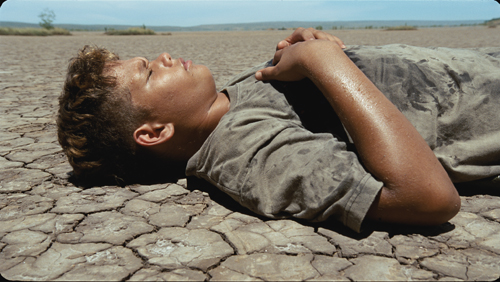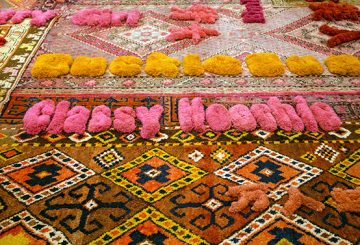Brendan Fletcher‘s debut feature film Mad Bastards has just opened in cinemas. He tells The Art Life’s Andrew Frost of the projects inspiration, the art of directing non-actors and the seven year journey to bring the story to the screen… And read on to learn how to win one of four double passes to the film.
Andrew Frost: Tell us about the script for the film. What was the inspiration for the story? And was the script that you initially wrote the one that you shot?
Brendan Fletcher: The script was an evolving beast. Unlike the standard practice it wasn’t a script or even a story that was the basis for this movie … it was the people I met up in the Kimberley. I felt like they were natural actors, so together we devised a story based on experiences from their lives. As a parallel process, I did acting workshops on film and video with them to, firstly, test and then secondly refine their natural ability. The result of this process over many years lead to a script we could raise money with. When we got the movie financed (after 7 years of development!), the script we went into production with was really a guide. Looking at the finished film today, the story is exactly the one that was on the page, but how we told each beat of the story was entirely up to our collaborative process. The “actors” would use language they wanted to use, and often scene ideas came from the actors themselves, but it was all within the framework of the story beats that the narrative required. Basically we knew what had to happen at what point in the story, but how we realised that specifically was collaborative right up til when we shot it.
AF: Making Mad Bastards was quite an extended process – how long did it take to get from script to screen and what were the obstacles along the way?
BF: It was a very long and labour-intensive process. During our development and workshopping we had many false starts and explored many avenues that turned out to be cul-de-sacs. We collected enough stories to make 100 movies. It took 7 years to develop. But it was a fantastic life experience and it was done while I was making music videos and documentaries for the Pigram Brothers up in The Kimberley, so it all wound into one giant life adventure. An experience where you really live your project. Once we were financed – through the usual government bodies – it took 2 years to make the film. The obstacles were of every kind: financing was tough because I was a first time director with a cast of unknowns, the subject matter was “challenging” for commercial distributors – ie: black – the script was constantly evolving which was fantastic creatively but very difficult practically, we were filming in VERY remote locations. Wyndham our main location is 1200kms North East of Broome. You name it, it was hard.
AF: What was it like getting performances out of non actors? The director Gareth Edwards who made the recent sci-fi film Monsters says that the best way to handle non-actors is to not tell them what to do – would you agree with that? What do you get out of those kinds of performances?
BF: Yeah for sure. Fairly early on I realised that as long as they didn’t try to hard to “act” we’d be OK. I cast these people because when they were just being there they were very watch-able. That’s screen presence. Basically the more they could be themselves and just relax the better they were on camera. The tricky thing is when they needed to remember specific lines because the story needed it (and repeat them over and over again) – balancing that tonally with their improvisations (where you try not to tell them much) was hard for them. But they got it. And the funny thing was that as the shoot went on, my “non-actors” became “actors”! They started to be more comfortable with the process, with the cameras and all the goings on … and about half way through the shoot they even started to learn lines! By the end we were pretty much acting like a normal film crew.
AF: The music aspect of the film is very strong – did you conceptualize how you’d use source music in the film before it was shot? or was it something that grew out of the location and people?
BF: Right from the early stages the music was always designed to go in the film. Not just as a soundtrack, but literally people playing music in the scenes themselves. If you’ve seen the fabulous Soggy Bottom Boys in O Brother Where Art Thou you’ll know what I mean. I guess it’s because this is what actually happens in the Kimberley … and because I’d worked with the Pigram Brothers for so many years I knew that we had something special and that their music was a great way to transport the audience to another world. It’s worked out really well. Balancing the music with the narrative storytelling was tough to balance, but I just knew it was worth fighting to make it work – because the music is so good! The music also has a fabulous warmth that I really think helps to heal the characters (and the audience) from the harsher parts of the film.
AF: The film is quite violent at times, yet it has a very hopeful and positive message that seems more authentic for the fact that your film acknowledges the conflicted nature of masculinity. Do you suppose this film is specifically about the situation of Indigenous people, or is there a more universal message in Mad Bastards?
BF: It is absolutely a universal story. This has been proven to me time and time again … people from all walks of life come up to us and tell us how it resonated so truthfully with them. I think it is set in a unique world that even most Australians don’t really know, but the story is basic to humanity. Our screenings at Sundance really proved this too.
AF: You’ve been working in television and documentaries for awhile and this is your first feature – what plans have you got for the future? Any pet projects?
BF: I look forward to lying on the couch for a few days straight. It’s a been a long journey … and I’m pretty exhausted. I’d like to make more movies but TV and docos have a faster turnaround. I like having a mix of projects.
Want to win one of four double passes to see Mad Bastards? Send an email to: the art life at hot mail dot come explaining why you deserve to win by 5pm Monday May 9th. Include a postal address.




Because i took the time to read this article and missed the deadline by 30 minutes so i so deserve it…Cheers!
Any idea when I can buy this movie on DVD and from where?
The film has only just been released in the cinemas – it will take probably six months before it’s available on DVD – Art Life Management